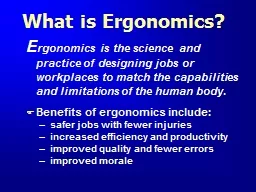/


E rgonomics is the science and practice of designing jobs or workplaces to match the capabilities and limitations of the human body Benefits of ergonomics include safer jobs with fewer injuries ID: 169816
Download Presentation The PPT/PDF document "What is Ergonomics?" is the property of its rightful owner. Permission is granted to download and print the materials on this web site for personal, non-commercial use only, and to display it on your personal computer provided you do not modify the materials and that you retain all copyright notices contained in the materials. By downloading content from our website, you accept the terms of this agreement.
Slide1
What is Ergonomics?
E
rgonomics is the science and practice of designing jobs or workplaces to match the capabilities and limitations of the human body
.
Benefits of ergonomics include:
safer jobs with fewer injuries
increased efficiency and productivity
improved quality and fewer errors
improved moraleSlide2
What is a Muscularskeletal Disorder?
An MSD is a disorder of the muscles, nerves, tendons, ligaments, joints, cartilage, blood vessels or spinal discs. Slide3
Workplace MSD’s are caused by
exposure to risk factors:
Repetition
Force
Awkward Postures
Contact StressVibration
WHAT IS A WMSD?Slide4
“Caution Zone” Jobs
Require Action
Do you have “caution zone” jobs?
Two requirements:
Awareness education
Evaluate “caution zone”
jobs for hazards
Reduce exposure below
the hazard level or
to the degree feasible
No additional
requirements
Not covered No requirements
Yes
Hazards present
No
No hazardspresent
Annual
review
Annual
reviewSlide5
"Caution Zone"
Caution
Zone
What is a
“Caution Zone” job
?Slide6
Awkward PosturesHigh Hand Force
Highly Repetitive Motion
Repeated Impact
Heavy, Frequent or Awkward LiftingModerate to High Hand-Arm Vibration"Caution Zone"
Caution
Zone
Look for These Indicators:Slide7
Awkward Postures
Being in these work positions for
more than 2 hours total per day
Hands above head Elbow above shoulder Back bent forward more than 30 degrees Neck bent more than 30 degrees Squatting
Kneeling
"Caution Zone"Slide8
Working with the
Hands Overhead
For more than 2 hours per day
"Caution Zone"Slide9
Neck or Back Bent Forward More than 30º
For more than 2 hours per day
"Caution Zone"Slide10
Squatting or Kneeling
For more than 2 hours per day
"Caution Zone"Slide11
High Hand
Force
More than 2 hours per
day of:
Pinching 2 or more pounds weight or 4 or more pounds force
Gripping 10 or more pounds weight or force
"Caution Zone"Slide12
Highly Repetitive Motion
Workers repeat same motion every few seconds for
more than 2 hours per day
with:neckshoulderselbowswristshands
"Caution Zone"Slide13
Highly Repetitive Motion
Intensive keying for
more than 4 hours per day
"Caution Zone"Slide14
Repeated Impact
Using hands or knees as a hammer
more than
10 times per hour more than 2 hours per day
"Caution Zone"Slide15
Heavy, Frequent, or Awkward Lifting
Lifting objects more than:
75 lbs.
once/day 55 lbs. more than ten times/day 10 lbs. more than twice/minute
for more than
2 hours per day 25 lbs. above shoulders, below knees, or at arms length for more than
25 times/day
"Caution Zone"Slide16
Moderate to High
Hand-Arm Vibration
High Level
Moderate Levelmore than
2 hours/day
More than
30 Min/day
"Caution Zone"Slide17
Analyzing Caution Zone Jobs for
Hazards
Use a systematic method to look at:
physical demandslayout of work areasize, shape, and weight of objects handledThe results will help to determine controls
"Hazard"Slide18
Hazard Zone
(use Appendix B)
Risk factors become hazardous when:
there is a longer duration of exposure
"Hazard"Slide19
Hazard Zone(use Appendix B)
Risk factors become hazardous when:
there is greater intensity
"Hazard"Slide20
Risk factors become hazardous when:
there is a
combination
of risk factors
"Hazard"
Hazard Zone
(use Appendix B)Slide21
Ergonomic Solutions
Using foot controls instead of standard mice controls
"Solutions"Slide22
"Solutions"
Ergonomic Solutions
Lift assist device to eliminate heavy,
awkward liftsSlide23
Shoulder harness for landscaping tool to reduce hand forces
"Solutions"
Ergonomic SolutionsSlide24
Voice activated software to eliminate keystrokes
Ergonomic Solutions
"Solutions"Slide25
If You Have
“Caution Zone” Jobs
Begin an employee awareness education program
Analyze your workplace for hazardsReduce any hazards you findSlide26
Ergonomics Awareness Education Should:
Provide information on all “caution zone” risk factors
Show the types, symptoms and impacts of WMSDs
Show the importance of early reporting of symptomsIdentify the hazards and measures to reduce themTeach the requirements of the ergonomics ruleSlide27
Reducing Identified
Hazards
You need to reduce hazards to below hazard level, or to a degree technologically and economically feasible through:
Engineering and administrative controls (preferred) and/orIndividual work practices and PPEEmployers are not required to reduce employee hours to complySlide28
Job-Specific Training
Job-specific training is required only if controls change the job or work practices
Training must include:
hazards of the work activitiessafe work practicesproper use and maintenance of control measuresSlide29
Employee
Involvement
Your safety committee should be involved in selecting the methods of employee participation
Involve your employees in:Analyzing “Caution Zone” JobsSelecting hazard control methodsReviewing ergonomics activities annuallyResults should be shared with your safety committeeSlide30
Remember: “Caution Zone” Jobs
Require Action
Do you have “caution zone” jobs?
Two requirements:
Awareness education
Evaluate “caution zone”
jobs for hazards
Reduce exposure below
the hazard level or
to the degree feasible
No additional
requirements
Not covered No requirements
Yes
Hazards present
No
No hazardspresent
Annual
review
Annual
reviewSlide31
It Costs Less to Be Safe
Average cost of
Average cost of
common
WMSDs*:
common controls:
Low back: $6,000
Hydraulic lift: $600
Shoulder: $7,000
Adjustable height
workstation: $800
Elbow: $4,000
Powered screwdriver:
$100
Wrist: $5,500
Assembly work
positioner: $75
* Source: SHARP Report No. 40-4a-2000